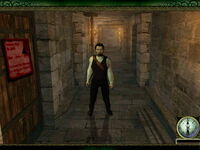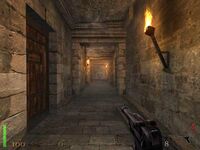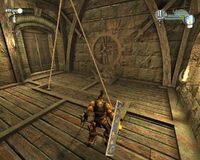Limbo of the Lost was originally developed in the 90s by Steve Bovis and Tim Croucher. Using an initial prototype made on the Atari ST, the two pitched the concept to publishers. Unfortunately, as is often the case, the publishers wanted a finished product. This stymied the pair's efforts until 1995 when Bovis, Croucher and Laurence Francis began working on the game again this time as a point and click adventure for the Amiga A500. Rasputin Software picked up the title on the Amiga 1200 and Amiga CD32. Unfortunately, Limbo of the Lost never made it to store shelves since, by the time it was ready, the systems it was made for were dead.
Finally, in 2003, Bovis once again restarted development on Limbo of the Lost. Bovis, Croucher, and Francis redesigned and rebuilt the game. In 2007, G2 Games published it in Europe. Boxed copies, however, were extremely rare and the game was mostly available only through online distribution. Then, in 2008, Tri Synergy announced a wide release in North America.
Plagiarism accusations
On June 11, 2008 GamePlasma published an article comparing specific scenes in Limbo of the Lost with a nearly identical space in The Elder Scrolls IV: Oblivion. The gaming community pounced on this revelation and soon discovered background and objects that appeared to originate from, according to Wikipedia: "The Elder Scrolls III: Morrowind, Unreal Tournament 2004 and 2003, Diablo II, Thief: The Dark Project, Thief: Deadly Shadows, a CryENGINE2 Tech Demo, Silent Hill 4: The Room, Return to Castle Wolfenstein, Painkiller and its expansion pack Painkiller: Battle out of Hell, Vampire: The Masquerade - Bloodlines, The Lord of the Rings: The Battle for Middle-Earth, Hexen and World of Warcraft. Other scenes appear to be taken from live action films: one from the 1997 film Spawn, another from Pirates of the Caribbean: The Curse of the Black Pearl and several more from its sequel, At World's End."
When the plagiarism was first discovered, many were incredulous that the developers could actually get away with such blatant copyright violation. Some posited that it may be an ARG (Alternate Reality Game).
Tri-Synergy has stopped distribution of Limbo of the Lost and says they were unaware that Majestic Studios (Bovis, Croucher, and Laurence) had plagiarized game content. Majestic Studios stated that they were unaware of the plagiarism and that a contractor was responsible for it. They have not, however, named this contractor and their claim appears spurious for many other reason listed below.
Laurence Francis and Tim Croucher, the only two founding members other than Steve Bovis, posted this message stating that they had nothing to do with the graphics and were withdrawing from Majestic Studios due to the actions of "certain team members"
Developer's claims
In their statement to the press, on June 23rd, 2008, the developers finally stated that the plagiarized art had come from a contractor that they outsourced to.
However, in December 2004, Steve Bovis posted on the Wintermute Engine forums stating that:
The backgrounds are created in 3D GAMESTUDIO A6 , they are textured, lit and then I place a camera at a certain position and grab a still. This becomes the initial background plate.
In this same post, he links to a gallery of screenshots that contain plagiarized assets from Return to Castle Wolfenstein. This suggests that he was referring directly to having created the precise screenshots linked to, with the method mentioned above. However, it is entirely possible that a third party created the plagiarised backgrounds and that he was simply taking credit for them, or that he was referring to the way in which he, specifically, worked. This does seem unlikely given his claims about his role in the development team shown below.
|
Limbo of the Lost   |
Return to Castle Wolfenstein   |
This lends credence to the theory that Steve Bovis deliberately stole copyrighted content from other videogames.
In addition, in an interview with Just Adventure, Steve Bovis listed the other team members as being Tim Croucher, Laurence Francis, Marko "Gravehill" Hautamäki, Lisa Highsted, and Heather Banks. None of them are attributed as being responsible for any art creation. Additionally, he is quoted as saying:
My job is to put the game together and create all the visuals, coding, sounds, models, marketing and basically make the game flow and work. As well as manage and try to motivate the team. A job that is hard enough at the best of times!
Not only does he not mention any outsourcing, he also states that his job is to "create all the visuals" for the game.
Some have posited that perhaps the developers didn't know that they were breaking copyright. Perhaps they were just that clueless. Bovis's claim that he created the backgrounds in 3D GameSudio, however, makes that theory very unlikely. In this statement, he clearly lies about creating the background art using a 3D package when comparison shots have proven that the ONLY way these screenshots could have been created is by taking a screenshot of Return to Castle Wolfentstein and then overlaying other images in Photoshop.
Several of Bovis's statements on the Wintermute Engine Forum document his personal involvement in various aspects of the game's graphics:
- August 24, 2004: "You see I am a game designer, modeller, artist, sound technician, level designer, character designer, writer but not very good at the coding thang."
- November 19, 2004: "I have created the compass as a sprite and the needdle spins in a loop."
- November 29, 2004: [on Poser] "Remember though as with all graphic software you get out what you put in. You need imagination and artistic flare to really push these tools. (the tool itself is not enough!!)"
- December 2, 2004: "I believe if you create excellent good looking models in a high poly modeller and then animate using, say poser 5. Then save as TGA or BMP, import into Sprite edit and then into the WME engine you would be surprised at the results. I was, and am using this method for all my NPC`s for my project LIMBO of the LOST."
- December 9, 2004: "The backgrounds are created in 3D GAMESTUDIO A6 , they are textured, lit and then I place a camera at a certain position and grab a still. This becomes the initial background plate."
- October 7, 2005: "I have thought of all that you have said and have gone with the complete copy of the main actor but cut off at the knees, the reason is that the water is highly deatailed and I want to keep it this way."
- May 24, 2006: "Thanks for your input but I am not a scripter or programmer I am a Visuals and game designer, I can work out the mechanics and design scenes and any graphics you can think of, 2D and 3D, animate, story line etc etc but I cannot for the life of me script."
- June 12, 2006: "I have created around 46 characters for my project from the main character to main NPC`s to background creatures."
Steve Bovis' sockpuppet, FABLE, demonstrated knowledge of Oblivion in a GameBoomers forum post on November 20, 2007: "I am mostly talking about full game reviews that you read on the web that in my opinion spoil some surprises, look at THE WITCHER, or OBLIVION reviews and you will see what I mean."
Given the amount of art stolen for LotL, it is possible that some of the remaining, unidentified, art comes from 3D Gamestudio project content.
Plagiarized design
One element of LotL's game design that is particularly surprising to note is that some puzzles are plagiarized directly from other games. For instance, in the screenshots below, you can see a comparison of LotL versus Enclave. The screenshots clearly shot a plagiarized environment, but beyond that, the PUZZLE associated with the environment itself is stolen in Lotl.
In LotL, there is a lever that the player can try to use, but it does nothing. Instead, they have to sever the ropes in order to drop an object on the floor below. The lever that they cannot use is actually from a similar puzzle in that environment in Enclave. In Enclave, the player must pull that lever to raise a gate held by those ropes. It boggles the mind -- LotL's puzzle uses elements directly from the Enclave puzzle, but the solution to the Enclave puzzle (the lever) is left as a red herring in LotL.
One final note -- the screenshot from enclave used for this puzzle is the ONLY screenshot in the entire game, as far as has been discovered, that is flipped horizontally (the reference image from Enclave below was also flipped to show the correlation). All other screenshots throughout LotL are used verbatim in their original in-game orientation. It is as if the developer knew that this was the most ludicrous piece of plagiarizm in the game and went out of their way to try to hide it by flipping the image.
 |
 |